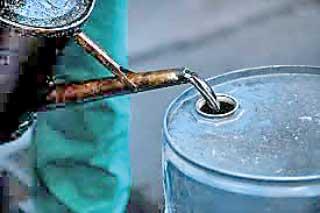11 Jun 2021 - {{hitsCtrl.values.hits}}
The global crude oil prices have gradually passed the US$ 70 a barrel and are advancing further, worsening the external and economic crisis brewing in Sri Lanka.
 The global crude oil prices at the Brent futures exchange— the global benchmark for crude oil— surpassed US$ 70 mark for a barrel on June 1, reaching the highest in over two years and have remained stubbornly above that level so far as demand for oil is strengthening with the recovery in advanced economies and major industrial nations in the world.
The global crude oil prices at the Brent futures exchange— the global benchmark for crude oil— surpassed US$ 70 mark for a barrel on June 1, reaching the highest in over two years and have remained stubbornly above that level so far as demand for oil is strengthening with the recovery in advanced economies and major industrial nations in the world.
Persistently high oil price over US$ 60 a barrel should unsettle policymakers as they mostly made their economic projections assuming oil would hover around the US$ 60 range during 2021 after the price fell to its depths during the most intense global economic shutdown during April last year. The Central Bank recently said oil prices continuously above US$ 60 a barrel could spell trouble for the country’s external sector, spilling over into the economy as its medium term projections are based on oil at US$ 60 a barrel.
“In our Balance of Payment projections, we are assuming the fuel prices to be at an average of US$ 60.0 a barrel. Anything beyond that will have some impact on the Balance of Payment’s performance, but anything below that will be a bonus,” said Dr. Chandranath Amarasekara, Director of Economic Research at the Central Bank speaking at a seminar held this February.
A few weeks ago, Central Bank Governor, Prof. W. D. Lakshman partly attributed the rising fuel bill for the fast ascent in the country’s import bill in March and the expanded trade deficit in that month, reflecting what an increase in oil prices could do to the country’s external sector.
“The recent rise in expenditure on imports is a concern, which is partly driven by the increased petroleum bill,” the Governor said.
In March, Sri Lanka’s fuel bill rose by 46.1 percent to US$ 347.2 million, of which the country spent US$ 310.5 million on refined petroleum products, logging over 100 percent increase over the same month in 2020, partly as a result of lower base effects.
While Sri Lanka might in the short-term get over the persistently high oil prices due to the prevailing restrictions on travel and other economic activities, the March data was an indication of what the economy would have to contend with, once the country is fully re-opened for business.
However, any adverse impact stemming from rising oil prices could be offset if the country can maintain a working economy, which adds capacity for merchandise exports creating economic opportunities for its people, as locking them out of work and other economic activities will only turn worsen the situation.
19 Nov 2024 13 minute ago
19 Nov 2024 2 hours ago
19 Nov 2024 4 hours ago
18 Nov 2024 18 Nov 2024
18 Nov 2024 18 Nov 2024